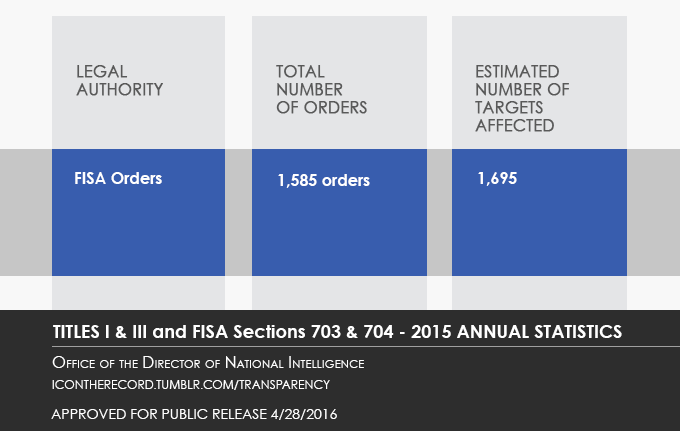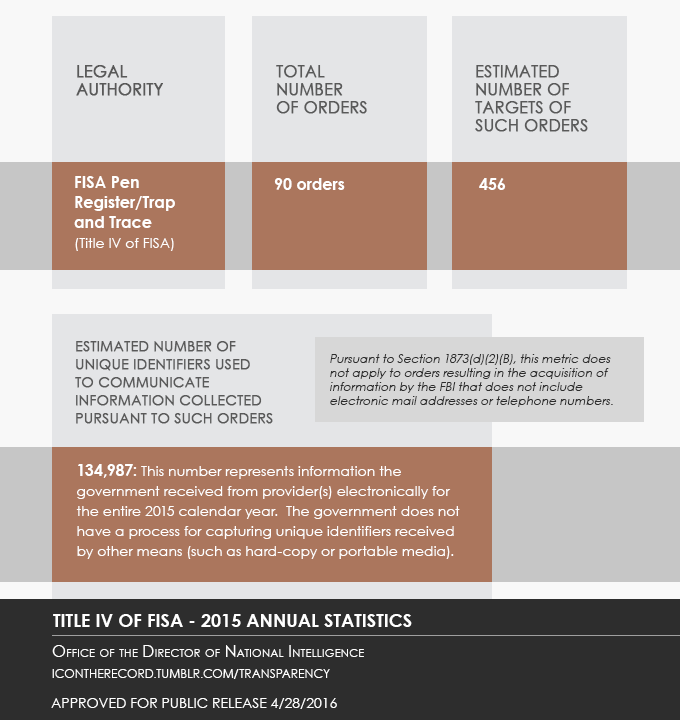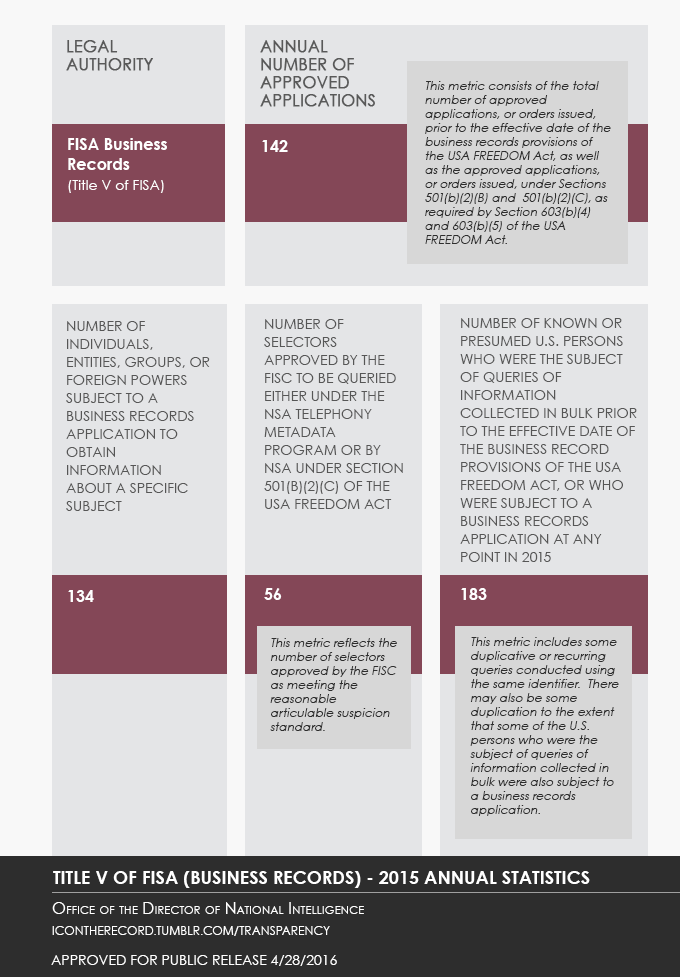Statistical Transparency Report Regarding Use of National Security Authorities - Annual Statistics for Calendar Year 2015
In June 2013, President Obama directed the Intelligence Community (IC) to declassify and make public as much information as possible about certain sensitive U.S. government surveillance programs while protecting sensitive classified intelligence and national security information.
Since then, the Director of National Intelligence has declassified and authorized the public release of thousands of pages of documents relating to the use of critical national security authorities, including the Foreign Intelligence Surveillance Act. In addition to declassifying and publicly releasing these documents, the Intelligence Community has published several reports regarding these authorities, including the Statistical Transparency Report Regarding use of National Security Authorities, presenting metrics related to the use of certain authorities for calendar years 2013 and 2014.
On June 2, 2015, the USA FREEDOM Act was enacted, codifying many of the statistics reported in the DNI’s annual transparency reports. The Act also expanded the scope of the information included in the reports by requiring the DNI to report information concerning United States person search terms and queries of certain unminimized, FISA-acquired information, as well as information concerning unique identifiers used to communicate information collected pursuant to certain FISA orders. [1] The IC implemented the USA FREEDOM Act on November 30, 2015. [2]
Today, consistent with the USA FREEDOM Act and the IC’s Principles of Intelligence Transparency, we are releasing our third annual transparency report presenting statistics on how often the government uses certain national security authorities. The DNI has declassified and directed the release of the applicable statistics covering calendar year 2015.
This information is available at the website of the Office of the Director of National Intelligence; and ODNI’s public website dedicated to fostering greater public visibility into the intelligence activities of the U.S. government, icontherecord.tumblr.com.
It is important to provide some additional context to the numbers included in this report:
Types of Orders: There are several different types of orders that the Foreign Intelligence Surveillance Court may issue in connection with FISA cases: orders granting or modifying the government’s authority to conduct intelligence collection; orders directing electronic communication service providers to provide any technical assistance necessary to implement the authorized intelligence collection; supplemental orders and briefing orders requiring the government to take a particular action or provide the court with specific information; and so on
Under Section 702, rather than issuing an individual order authorizing the government to target each non-U.S. person reasonably believed to be located outside the United States who possesses, or who is likely to communicate or receive, foreign intelligence information, the FISC issues a single order [3]approving certifications that describe categories of foreign intelligence information to be acquired through the targeting of non-U.S. persons reasonably believed to be located outside the United States.
Unless otherwise indicated, only the orders granting authority to conduct intelligence collection under the applicable FISA section are counted in this report; the other types of orders (e.g., modification orders) are not included.
Amendments and Renewals: The FISC may amend an order one or more times after it has been issued. For example, an order may be amended to add a newly discovered account used by the target. This report does not count such amendments separately. Moreover, some orders may be renewed multiple times during the calendar year (e.g., the FISA statute provides that a Section 704 FISA order against a U.S. person target may last no longer than 90 days but permits the order to be renewed). Unlike amendments, this report does count each such renewal as a separate order.
Targets: Within the IC, the term “target” has multiple meanings. With respect to the statistics provided in this report, the term “target” is defined as the individual person, group, entity comprised of multiple individuals, or foreign power that uses the selector, such as a telephone number or email address. If a target were known to use four different selectors, the IC would count one target, not four. Alternatively, if four targets were known to use a one selector, the IC would count four targets.
The term “target” can also be used as a verb. Under Section 702, for example, the IC “targets” a particular non-U.S. person, group, or entity reasonably believed to be located outside the United States and who possesses, or who is likely to communicate or receive, foreign intelligence information, by “tasking” selectors that are assessed to be used by such non-U.S. person, group or entity, pursuant to targeting procedures approved by the FISC.
The number of 702 “targets” reflects an estimate of the number of known users of tasked selectors. This estimate is based on the information readily available to the IC. Unless and until the IC has information that links multiple selectors to a single foreign intelligence target, each individual selector is counted as a being associated with a separate target in this report. On the other hand, where the IC is aware that multiple selectors are used by the same target, the IC counts the user of those selectors as a single target. This method of estimating helps ensure that the IC does not inadvertently understate the number of discrete persons targeted pursuant to Section 702.
Title V of FISA: The IC implemented the USA FREEDOM Act’s Title V provisions on November 30, 2015, resulting in one additional month’s worth of data for calendar year 2015. Because statistical information tied to a particular FISA authority for a particular month remains classified, Title V data specifically associated with December 2015 – i.e., the information required under Section 603 (b)(4)(A) and (B) and 603 (b)(5)(A), (B) and © – is included only in the classified annex to this report that has been provided to Congress.
U.S. Persons: In calculating the metrics in this report, the IC applied the broader definition of the term “U.S. Person” used in FISA, rather than USA FREEDOM Act’s narrower “U.S. Person” definition. Section 603(e)(4) of the USA FREEDOM Act defines “U.S. Person” as “a citizen of the United States or an alien lawfully admitted for permanent residence (as defined in section 101(a) of the Immigration and Nationality Act (8 U.S.C. § 1101(a))).”
This definition is narrower than FISA’s, which defines “U.S. Person” as a citizen of the United States or an alien lawfully admitted for permanent residence (as defined in section 101(a)(20) of the Immigration and Nationality Act), an unincorporated association a substantial number of members of which are citizens of the United States or aliens lawfully admitted for permanent residence, or a corporation which is incorporated in the United States, but does not include a corporation or an association which is a foreign power, as defined in 50 U.S.C. § 1801(a)(1), (2), or (3). Because the broader FISA definition is the one that governs how U.S. person queries are conducted pursuant to the relevant minimization procedures, it also governs how those queries are counted. It is not possible to isolate U.S. person search terms that only meet the USA FREEDOM Act’s narrower definition.
Unique identifiers used to communicate information collected pursuant to such orders: This language describes metrics included in the Title IV (PR/TT) portion of the report and in the Title V information covered in the classified annex to the report. The House Report on the USA FREEDOM Act states that “[t]he phrase ‘unique identifiers used to communicate information collected pursuant to such orders’ means the total number of, for example, email addresses or phone numbers that have been collected as a result of these particular types of FISA orders–not just the number of target email addresses or phone numbers.” H. Rept. 114-109 Part I.
Titles I & III and Sections 703 & 704 of FISA - 2015 Annual Statistics

Section 702 of FISA - 2015 Annual Statistics

See the DNI’s certification as to the estimated number of queries concerning a known U.S. person of unminimized noncontents information under Section 702.
Response to PCLOB Recommendation 9(5)
In response to Recommendation 9(5) of the Report on the Surveillance Program Operated Pursuant to Section 702 of the Foreign Intelligence Surveillance Act, prepared by the Privacy and Civil Liberties Oversight Board, National Security Agency provides the following additional information regarding the dissemination of Section 702 intelligence reports that contain U.S. person information.
Section 702 only permits the targeting of non-U.S. persons reasonably believed to be located outside the United States to acquire foreign intelligence information. Such targets, however, may on occasion communicate information of or about U.S. persons. Where appropriate, NSA may disseminate such information concerning U.S. persons.
NSA only generates signals intelligence reports in response to a specific intelligence requirement, regardless of whether the proposed report contains U.S. person information. NSA’s minimization procedures expressly prohibit dissemination of information about U.S. persons in any NSA report unless that information is necessary to understand foreign intelligence information or assess its importance, contains evidence of a crime, or indicates a threat of death or serious bodily injury.
Even if one of these conditions applies, NSA often will mask the information and will, under any circumstance, include no more than the minimum amount of U.S. person information necessary to understand the foreign intelligence or to describe the crime or threat. In certain instances, however, NSA makes a determination prior to releasing its original report that the U.S. person’s identity is appropriate to disseminate in the first instance using the same standards discussed above.
In 2015, NSA disseminated 4,290 FAA Section 702 intelligence reports that included U.S. person information. Of those 4,290 reports, the U.S. person information was masked in 3,168 reports and unmasked in 1,122 reports.
Recipients of NSA reporting can request that NSA provide the true identity of a masked U.S. person referenced in an intelligence report, but this information is released only if the recipient has a legitimate need to know the identity and dissemination of the U.S. person’s identity has been determined to be necessary to understand foreign intelligence information or assess its importance, contains evidence of a crime, or indicates a threat of death or serious bodily injury.
Under NSA policy, NSA is allowed to unmask the identity for the specific requesting recipient only under certain conditions and where specific additional controls are in place to preclude its further dissemination, and additional approval has been provided by a designated NSA official. In 2015, NSA released 654 U.S. person identities in response to such requests.
Finally, as part of their regular oversight reviews, the Department of Justice and the Office of the Director of National Intelligence review disseminations of information about U.S. persons that NSA obtained pursuant to Section 702 to ensure that the disseminations were performed in compliance with the minimization procedures. For additional information, see page 7 of the NSA Director of Civil Liberties and Privacy Office Report, NSA’s Implementation of Foreign Intelligence Surveillance Act Section 702.
Title IV of FISA - 2015 Annual Statistics

Title V of FISA (Business Records) - 2015 Annual Statistics

National Security Letters - 2015 Annual Statistics

View the Department of Justice Annual Foreign Intelligence Surveillance Act Report to Congress
Download a PDF of the 2015 IC Transparency Report | View the DNI’s Certification Letter
View the 2013 IC Report | View the 2014 IC Report | Visit the Main IC Transparency Page
NOTES:
[1] See 50 U.S.C. § 1873(b).
[2] Although the USA FREEDOM Act was not implemented until November 30, 2015, the metrics provided in this report represent the full 2015 calendar year except where otherwise stated.
[3] Note that, in its own transparency report, which is also required pursuant to Sec. 603 of the USA FREEDOM Act, the Director of the Administrative Office of the United States Courts (AOUSC) counted each Section 702 certification as being associated with its own order. Because the number of the government’s Section 702 certifications remains a classified fact, the government requested that the AOUSC redact the number of certifications and the number of modified orders from its transparency report prior to publicly releasing it.